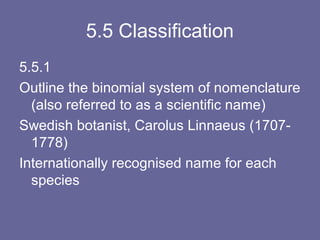
Classification and Identification of Organisms
- 1. 5.5 Classification 5.5.1 Outline the binomial system of nomenclature (also referred to as a scientific name) Swedish botanist, Carolus Linnaeus (17071778) Internationally recognised name for each species
- 2. 5.5 Classification Rules for binomial nomenclature: 1. The first name is the Genus name 2. The Genus name is CAPITALISED 3. The second name is the species name 4. The species name is not capitalised 5. Italics are used if the name is printed 6. The name is underlined if handwritten Homo sapiens, Panthera leo, etc.
- 3. 5.5 Classification 5.5.2 List the seven levels in the hierarchy of taxa - use an example from two different kingdoms for each level.
- 5. Dusky Leaf Monkey o ! n w o r Animalia Chordata Mammalia Primates Cercopithecidae Trachypithecus T. obscurus m r k a u o y e Plantae Magnoliophyta Magnoliopsida Malvales Malvaceae Hibiscus Gross Sometimes Kingdom Phylum Class Order Family Genus Species Hibiscus H. rosa-sinensis Kings Play Chess On Folding Glass Stools Kissing Pretty Cute Otter Feels King Phillip Came Over For Good Soup
- 6. 5.5 Classification • 5.5.3 Distinguish between the following phyla of plants, using simple external recognition features: bryophyta, filicinophyta, coniferophyta and angiospermophyta. • 5.5.4 Distinguish between the following phyla of animals, using simple external recognition features: porifera, cnidaria, platyhelminthes, annelida, mollusca and arthropoda.
- 7. Bryophyta – mosses and liverworts (0.5m) • No roots, just rhizoids • Small • Spores produced in capsules Mosses have simple leaves and stems Liverworts have a flattened “thallus”
- 8. Filicinophyta – ferns (<15m) • • Roots, leaves and short (non-woody)stems Pinnate leaves • Curled up in buds • Spores in sporangia (underside of leaves) shallow roots
- 9. Coniferophyta – conifers (100m) • Shrubs or trees with roots, leaves and woody stems • Narrow leaves (needles) with thick waxy cuticle • Produce seeds from ovules in femaleones (& cones (pollen is produced from from smaller male cones)
- 10. Angiospermophyta – flowering plants (100m) • Roots, stems and leaves • If shrubs or trees, woody stems • Produce seeds from ovules inside ovaries. Fruits develop from ovaries, to disperse seeds
- 11. Porifera (sponges) • Poriferans don't have mouths or anuses; instead, they have tiny pores in their outer walls through which water is drawn. • No symmetry and sessile
- 12. Cnidaria (corals, anemones and jellyfish) • Single opening to stomach, that functions as both mouth and anus • It has radial symmetry • Has tentacles armed with stinging cells called nematocysts.
- 13. Platyhelminths (flatworms) • Bilaterally symmetrical • Flat bodies • No body cavity other than the gut • Mouth but no anus
- 14. Annelida (segmented worms) • Segmented, long body (often with chitae) • Mouth and anus • Bilaterally symmetrical
- 15. Mollusca • The body has a head, a foot and a mantle that typically secretes the shell. • The buccal cavity, at the anterior of the mollusc, contains a radula (a ribbon of teeth for feeding), anus at the posterior • The ventral foot is used in locomotion. • Not bilaterally symmetrical • No segmentation visible
- 16. Arthropoda • Exoskeleton made of chitin (may be strengthened with calcium carbonate) • Jointed limbs • Bilaterally symmetrical • Segmentation usually visible • Four classes: insects, arachnids, crustaceans, millipedes
- 17. 5.5 Classification • 5.5.5 Apply and design a key for a group of up to eight organisms. • A dichotomous key should be used.
- 18. Design a dichotomous key for 8 organisms
- 19. 5.5 Classification 5.5.1 Outline the binomial system of nomenclature (also referred to as a scientific name) Swedish botanist, Carolus Linnaeus (17071778) Internationally recognised name for each species
- 20. 5.5 Classification 5.5.2 List the seven levels in the hierarchy of taxa - use an example from two different kingdoms for each level.
- 21. 5.5 Classification • 5.5.3 Distinguish between the following phyla of plants, using simple external recognition features: bryophyta, filicinophyta, coniferophyta and angiospermophyta. • 5.5.4 Distinguish between the following phyla of animals, using simple external recognition features: porifera, cnidaria, platyhelminthes, annelida, mollusca and arthropoda.
- 22. 5.5 Classification • 5.5.5 Apply and design a key for a group of up to eight organisms. • A dichotomous key should be used.